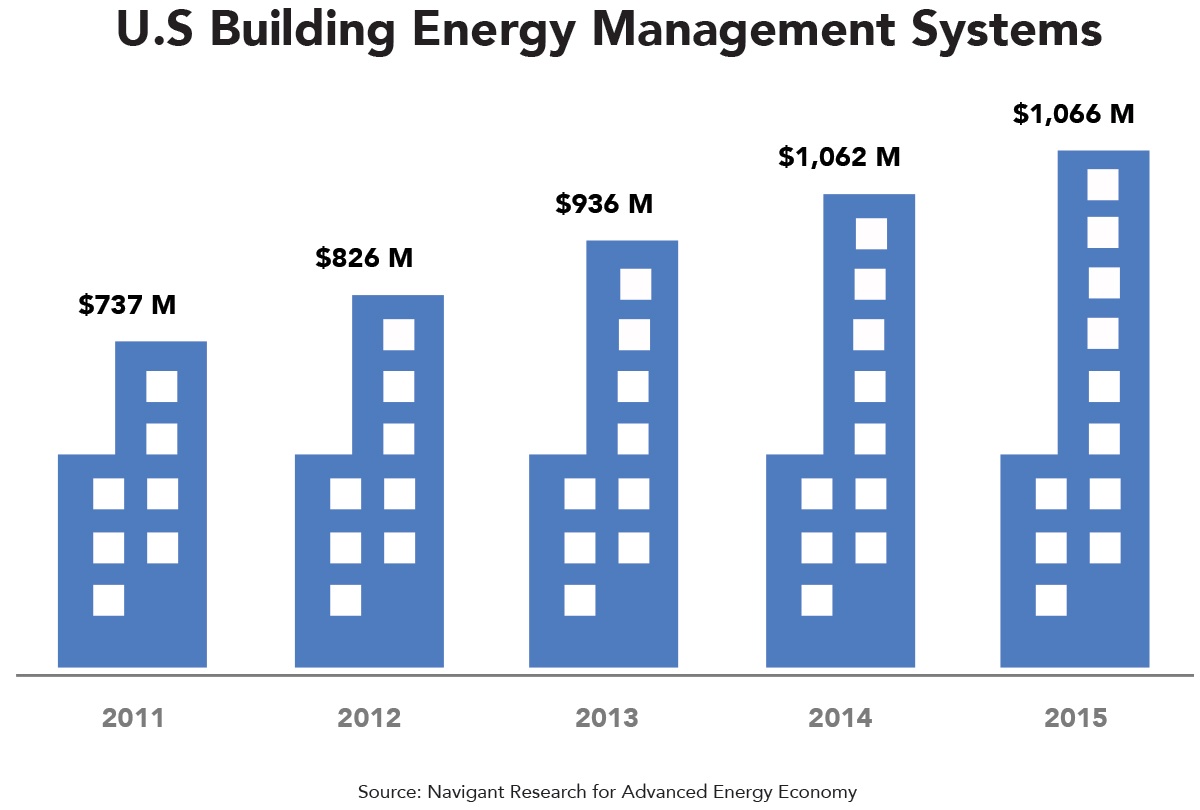This post is one in a series of feature stories on trends shaping advanced energy markets in the U.S. and around the world, drawn from Advanced Energy Now 2016 Market Report, which was prepared for AEE by Navigant Research.

The intelligent building is a facility that leverages information technology to improve system performance for energy savings and operational improvements. The market launched about a decade ago with new software, building energy management systems (BEMS), designed to deliver energy efficiency improvements by translating more data into better information and explicit action. BEMS combat the challenge of using and maintaining complex and proprietary control and automation systems. These new software solutions utilize a wider array of data including utility bills, smart meter interval data, weather, and sensor signals to identify opportunities for energy efficiency and operational improvements. BEMS are technology agnostic, so regardless of any existing control and automation infrastructure, the software applications can direct energy cost savings. For example, BEMS can detect anomalies in heating system operations and then direct a reset of setpoints or schedules. The result is better use of heating systems, which drives down utility bills. The energy efficiency story is straightforward and quantifiable. Customers see declining utility bills aligned with the performance improvements in their building systems.
A growing number of intelligent building applications are designed to maximize worker efficiency and satisfaction by improving responsiveness to heating and cooling complaints, easing the process of finding collaboration space, fine-tuning lighting to meet specific worker preferences, and showcasing energy, waste, and water conservation improvements that support corporate sustainability commitments. The line between building algorithms and business algorithms is blurring as connected, comfortable buildings come to define the modern workplace.
BEMS are central mechanisms for making buildings more intelligent, comfortable, and efficient. They are data-driven decision support tools for facilities and operations management. BEMS enable the strategic improvements in operations and maintenance, help guide investment in building system upgrades, and improve resource utilization within a facility or across a portfolio. This wide array of benefits helps drive investment in BEMS worldwide.
Revenue from BEMS was flat in 2015, at $2.8 billion globally and $1.1 billion in the United States, as the market continues to mature. But growth since 2011 has been substantial, up 50%, from $1.8 billion, in global revenue and 45% higher than 2011’s $737 million in U.S. revenue. (Figure 7.2) Navigant Research forecasts that global BEMS revenue will reach $10.8 billion in 2024.
An evolution in building technologies is reshaping how owners can leverage buildings as valuable assets. A couple of corporate moves that occurred in 2015 illustrate the kinds of changes that are happening in the building management business as BEMS and other technologies provide new capabilities in energy management and comfort:
-
CBRE made two significant investments to deepen capabilities in energy management, engineering, and supply chain management with the acquisitions of Johnson Controls’ Global Workforce Solutions business (for a purchase price of $1.5 billion), and Environmental Systems Inc. CBRE and other major real estate management and outsourcing firms continue to broaden their capabilities around intelligent building technologies and energy management to meet the shifting demands of both tenants and investors.
-
Energy and services provider Direct Energy completed the acquisition of Panoramic Power for $60 million. This transaction will enable Direct Energy to introduce device-level energy management to their customers.The move reflects the opportunity for energy providers to deepen engagements with their commercial customers beyond specific demand side management programs and putting them into new positions as trusted energy advisors.
-
The growing penetration of BEMS in commercial buildings provides greater insight and actionable information to stakeholders across the value chain including building owners, operators, and service providers. It is a win-win situation: BEMS drive energy savings that improve the bottom line, and at the same time make workspaces more comfortable and convenient.
The advanced energy industry is a market with $1.4 trillion in revenues worldwide. Download AEE's Advanced Energy Now 2016 Market Report to learn the full size and scope of this industry.
